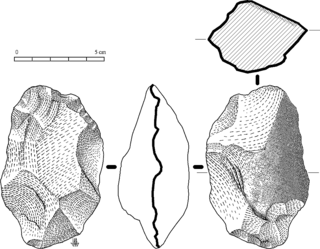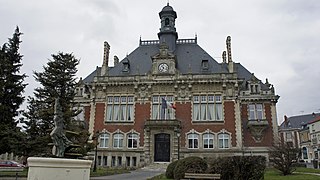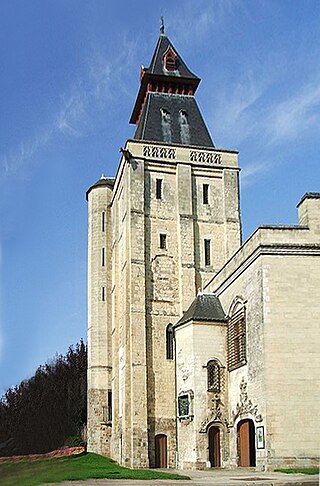Below are notable events in archaeology that occurred in 1838.

Sir Joseph Prestwich, FRS, FGS was a British geologist and businessman, known as an expert on the Tertiary Period and for having confirmed the findings of Boucher de Perthes of ancient flint tools in the Somme valley gravel beds.

Abbevillian is a term for the oldest lithic industry found in Europe, dated to between roughly 600,000 and 400,000 years ago.

Rethel is a commune in the Ardennes department in northern France. It is a sub-prefecture and third-most important city and economic center in the department. It is situated on the river Aisne, near the northern border of Champagne and 37 km from Reims.
Below are notable events in archaeology that occurred in 1847.
Below are notable events in archaeology that occurred in 1859.
Below are notable events in archaeology that occurred in 1863.
Below are notable events in archaeology that occurred in 1868.

Moulin Quignon, a quarry near Abbeville, France, celebrated for the discovery in 1863 by Boucher de Perthes of a human jawbone believed to be referable to the Quaternary period.
Dr Marcel-Jérôme Rigollot was a nineteenth-century French doctor and antiquarian famous for his role in the identification of evidence of some of Europe's earliest inhabitants.

Hangard is a commune in the Somme department in Hauts-de-France in northern France. The commune is centered on Hangard village.
Crèvecœur or Creve Coeur may refer to:

Abbeville is a commune in the Somme department and in Hauts-de-France region in northern France.

The National Archaeological Museum is a major French archaeology museum, covering pre-historic times to the Merovingian period (450–750). It is housed in the Château de Saint-Germain-en-Laye in the département of Yvelines, about 19 kilometres (12 mi) west of Paris.
Palaeoarchaeology is the archaeology of deep time. Paleoarchaeologists' studies focus on hominin fossils ranging from around 7,000,000 to 10,000 years ago, and human evolution and the ways in which humans have adapted to the environment in the past few million years.

Jacques Cambry was a Breton writer and expert in Celtic France. An early proponent of what came to be called Celtomania, he was the founder of the Celtic Academy, the forerunner of the Societé des Antiquaires de France. In addition, he is still honored as the "inventor" of the Oise département and praised for his contributions to the regional Breton identity as well as the national identity of post-Revolutionary France.
The discovery of human antiquity was a major achievement of science in the middle of the 19th century, and the foundation of scientific paleoanthropology. The antiquity of man, human antiquity, or in simpler language the age of the human race, are names given to the series of scientific debates it involved, which with modifications continue in the 21st century. These debates have clarified and given scientific evidence, from a number of disciplines, towards solving the basic question of dating the first human being.

François Poilly, or François de Poilly, was a French engraver.

Christophe-Paulin de La Poix, chevalier de Fréminville was a French Navy Commander, naturalist, archeologist and pioneer of transvestism.












